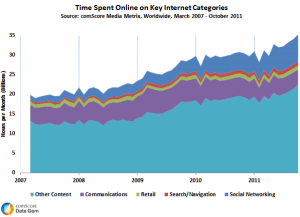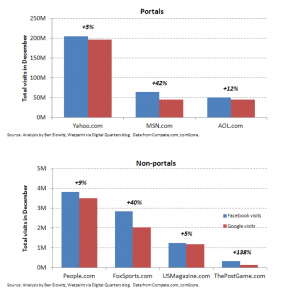Shift Happens
A major shift has taken place on the Web. Web pages and Web search are no longer the center of online activity and attention. Instead, the new center of attention is messaging and streams. We have moved from the era of the Web to the era of the Stream. This changes everything.
Back in 2009, I wrote an article called “Welcome to the Stream – Next Phase of the Web” which discussed the early signs of this shift. Around the same time, Erick Schonfeld, at TechCrunch, also used the term in his article, “Jump Into the Stream.” Many others undoubtedly were thinking the same thing: The Stream would be the next evolution of the Web.
What we predicted has come to pass, and now we’re in this new landscape of the Stream, facing new challenges and opportunities that we’re only beginning to understand.
In this series of articles I’m going to explore some of the implications of this shift to the Stream, and where I think this trend is going. Along the way we’re going to dive deep into some major sea changes, emerging problems, and new solutions.
From Documents to Messages
The shift to the Stream is the latest step in a cycle that seems to repeat. Online attention appears to swing like a pendulum from documents to messages and back every few decades.
Before the advent of the Web, the pendulum was swinging towards messaging. The center of online attention was messaging via email, chat and threaded discussions. People spent most of their online time doing things with messages. Secondarily, they spent time in documents, for example doing word-processing.
Then the Web was born and the pendulum swung rapidly from messages to documents. All of a sudden Web pages – documents – became more important than messages. During this period the Web browser became more important than the email client.
But with the growth of social media, the pendulum is swinging back from documents to messaging again.
Today, the focus of our online attention is increasingly focused towards messages, not Web pages. We are getting more messages, and more types of messages, from more apps and relationships, than ever before.
We’re not only getting social messages, we’re getting notifications messages. And they are coming to us from more places – especially from social networks, content providers, and social apps of all kinds.
More importantly, messages are now our starting points for the Web — we are discovering things on the Web from messages. When we visit Web pages, it’s more often a result of us finding some link via a message that was sent to us, or shared with us. The messages are where we begin, they are primary, and Web pages are secondary.
From Search to Social
Another sign of the shift from the Web to the Stream is that consumers are spending more time in social sites like Facebook, Pinterest and Twitter than on search engines or content sites.
In December of 2011, Comscore reported that social networking ranked as the most popular content category in online engagement, accounting for 19% of all consumer time spent online.
These trends have led some such as VC, Fred Wilson, to ask, “how long until social drives more traffic than search?” Fred’s observation was that his own blog was getting more traffic from social media sites than from Google.
Ben Elowitz, the CEO of Wetpaint, followed up on this by pointing out that according to several sources of metrics, the shift to social supplanting search as the primary traffic driver on the Web was well underway.
According to Ben’s analysis, the top 50 sites were getting almost as much traffic from Facebook as from Google by December of 2011. Seven of these top 50 sites were already getting 12% more visits from Facebook than from Google, up from 5 of these top sites just a month earlier.
The shift from search to social is just one of many signs that the era of the Stream has arrived and we are now in a different landscape than before.
The Web has changed, the focus is now on messages, not documents. This leads to many new challenges and opportunities. It’s almost as if we are in a new Web, starting from scratch – it’s 1994 all over again.
Click here to continue on to Part II of this series, Drowning in the Stream, where we’ll dig more deeply into some of the unique challenges of the Stream.


Pingback: The Shift Happening on the Web | Sundog
Pingback: The Message is the Medium – Attention is Shifting from the Web to the Stream | Digital Delights - Digital Tribes | Scoop.it
Pingback: The Message is the Medium – Attention is Shifting from the Web to the Stream | mondo technology | Scoop.it